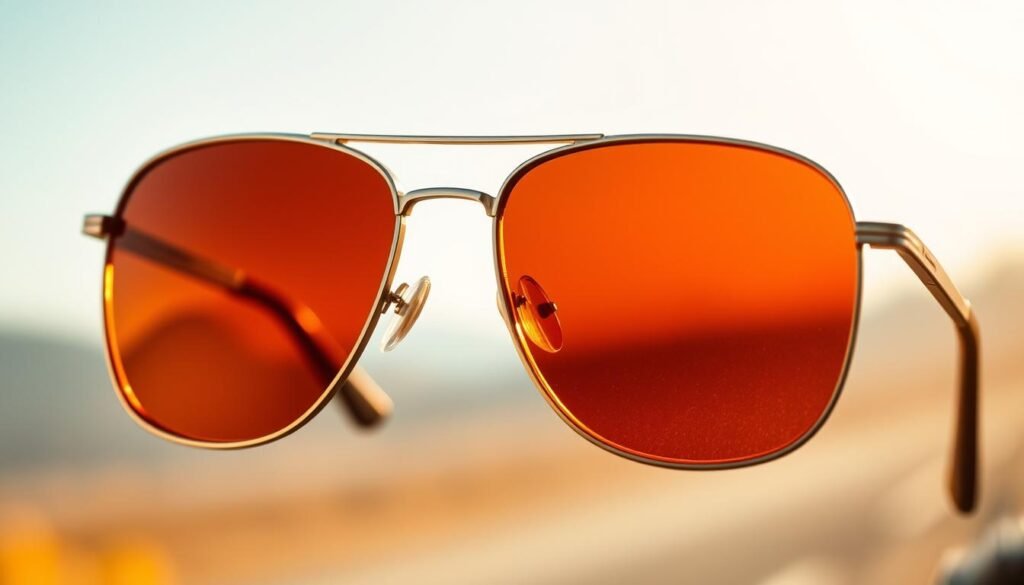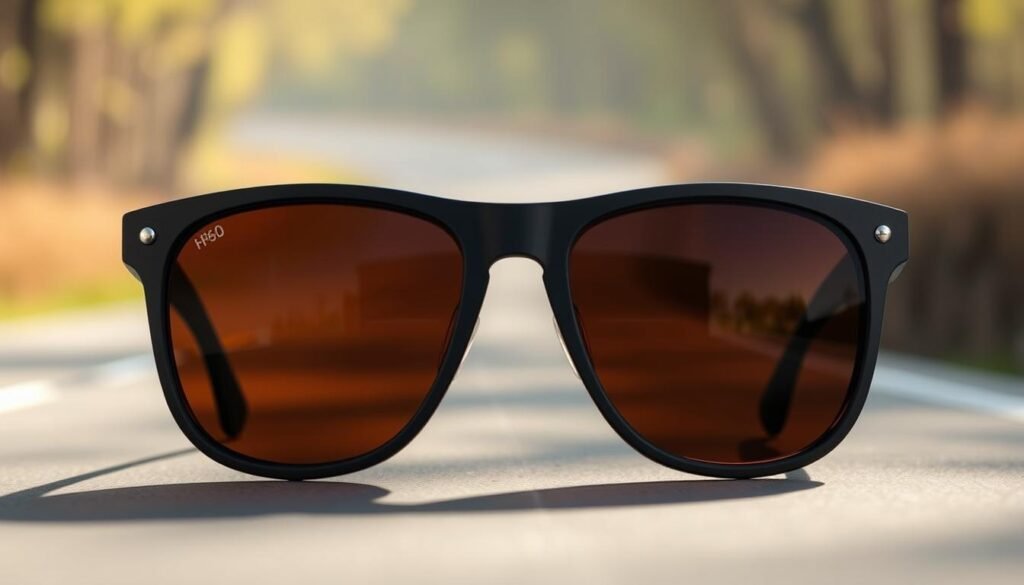When hitting the road, having the right eyewear is crucial for a safe and enjoyable journey. Driving sunglasses are not just a fashion statement; they play a significant role in reducing glare from the road and enhancing visibility. This is particularly important during peak sun hours or when driving through areas with high sun reflection.
The importance of proper eyewear while driving cannot be overstated. It not only protects your eyes from harmful UV rays but also improves your ability to see the road and potential hazards. With so many options available, choosing the best sunglasses can be overwhelming.
Key Takeaways
- Driving sunglasses reduce glare and enhance visibility.
- Proper eyewear protects your eyes from UV rays.
- The right sunglasses can improve your driving safety.
- Consider the type of lens and frame for optimal performance.
- Polarized lenses can be particularly beneficial for reducing glare.
Why Specialized Sunglasses Matter for Safe Driving
Driving safely requires more than just following traffic rules; it also demands the right eyewear to combat glare and UV exposure. The right sunglasses can significantly enhance driving safety and comfort.
The Dangers of Glare and Sun Exposure on the Road
Glare from the sun can be a significant hazard while driving, causing temporary blindness and increasing the risk of accidents. Prolonged exposure to UV rays can also lead to eye damage over time, including conditions like cataracts and macular degeneration.
How Proper Eyewear Enhances Driving Performance
Specialized sunglasses for driving are designed to reduce glare and provide UV protection, enhancing visual clarity and comfort. Polarized lenses, for instance, can significantly reduce reflective glare from surfaces like water, snow, and car windshields, improving reaction times and driving safety.
Statistics on Sun-Related Driving Accidents
According to the National Highway Traffic Safety Administration (NHTSA), a significant number of accidents are related to sun glare. Wearing appropriate sunglasses can mitigate this risk. Studies have shown that drivers who wear sunglasses with UV protection and glare-reducing lenses have a lower risk of being involved in sun-related accidents.
By understanding the risks associated with glare and sun exposure, and by wearing the right sunglasses, drivers can significantly enhance their safety on the road.
Key Features to Look for in Driving Sunglasses
The ideal driving sunglasses offer a combination of protection, visibility, and comfort. When selecting the perfect pair, several key features should be considered to ensure a safe and enjoyable driving experience.
UV Protection Requirements
One of the most critical features of driving sunglasses is UV protection. Exposure to ultraviolet rays can lead to eye damage, including cataracts and macular degeneration. Look for sunglasses that block 99-100% of UVA and UVB rays to safeguard your eye health.
Polarization Benefits for Drivers
Polarized lenses are another essential feature for driving sunglasses. They reduce glare from reflective surfaces like roads and water, enhancing visibility and reducing eye strain. This is particularly beneficial during night driving or in low-light conditions.
Frame Design Considerations
The frame design of your driving sunglasses can significantly impact your driving experience. Wrap-around frames provide maximum protection by preventing peripheral light from entering. Additionally, frames made from lightweight materials can enhance comfort during extended wear.
Lens Color and Tint Options
The color and tint of your sunglasses’ lenses can affect your visibility under different driving conditions. Various lens colors such as gray, brown, and yellow offer different benefits. For instance, gray lenses are ideal for bright, sunny days, while yellow lenses can enhance visibility in low-light conditions.
By considering these key features—UV protection, polarization, frame design, and lens color—you can find the perfect driving sunglasses to enhance your safety and comfort on the road.
The Best Sunglasses to Wear While Driving: Top Brands and Models
For drivers, the quest for the perfect sunglasses is about more than just fashion; it’s about functionality. The right pair can enhance driving comfort, reduce glare, and improve safety on the road.
Maui Jim Hookipa and Peahi Models
Maui Jim is renowned for its high-quality, polarized lenses that offer superior glare reduction. The Hookipa and Peahi models are particularly popular among drivers due to their stylish designs and excellent optical clarity. These models provide 100% UV protection, making them a great choice for long drives.
Ray-Ban Chromance and Aviator Designs
Ray-Ban’s Chromance lenses are designed to change color in response to different light conditions, offering versatility for drivers who encounter varying light environments. The Aviator design, with its iconic style, also provides a wide field of vision, which is beneficial for driving. The combination of style and functionality makes Ray-Ban a top choice.
Oakley Holbrook and Flak 2.0 XL Options
Oakley’s Holbrook and Flak 2.0 XL models are designed with drivers in mind, offering high-performance lenses that reduce glare and improve visibility. The Flak 2.0 XL’s large lenses provide extensive coverage, while the Holbrook’s classic design ensures comfort and style.
Serengeti Drivers Collection
Serengeti’s Drivers Collection is tailored to meet the needs of drivers, with features like photochromic lenses that adjust to changing light conditions. These sunglasses are designed to reduce eye strain and improve driving comfort, making them an excellent choice for daily commutes or long road trips.
| Brand/Model | Lens Feature | Frame Style |
|---|---|---|
| Maui Jim Hookipa/Peahi | Polarized | Aviator/Wrap-around |
| Ray-Ban Chromance/Aviator | Color-changing | Aviator |
| Oakley Holbrook/Flak 2.0 XL | Polarized/PRIZM | Classic/Sporty |
| Serengeti Drivers Collection | Photochromic | Various |
When choosing the best sunglasses for driving, it’s essential to consider both the functional aspects, such as lens type and UV protection, and the style, to ensure comfort and satisfaction. The brands and models discussed offer a mix of these qualities, catering to different preferences and needs.
Polarized vs. Non-Polarized Lenses for Driving
For drivers, understanding the differences between polarized and non-polarized lenses is crucial for reducing glare and enhancing driving performance. The choice between these two types of lenses can significantly impact your driving experience.
How Polarization Reduces Reflective Glare
Polarized lenses are designed to filter out horizontally polarized light, which is the type of light that reflects off surfaces like water, snow, and car windshields. By reducing this glare, polarized lenses improve visibility and reduce eye strain. For instance, during a sunny day, polarized lenses can minimize the glare from oncoming traffic, making driving safer.
When Non-Polarized Might Be Preferable
While polarized lenses offer several benefits, there are situations where non-polarized lenses might be preferable. For example, drivers who frequently use LCD screens in their vehicles might find that polarized lenses make these screens harder to read due to the polarization effect. Additionally, non-polarized lenses are often less expensive and still provide excellent UV protection.
Price Differences and Value Considerations
The price difference between polarized and non-polarized lenses can be significant. Polarized lenses, especially those from high-quality brands, tend to be more expensive due to the advanced technology used in their manufacture. However, the added benefits of glare reduction and improved visibility can make them a worthwhile investment for many drivers.
| Lens Type | Glare Reduction | Price Range |
|---|---|---|
| Polarized | Excellent | $50-$200 |
| Non-Polarized | Good | $20-$100 |
In conclusion, the choice between polarized and non-polarized lenses for driving depends on your specific needs and preferences. By considering factors such as glare reduction, screen visibility, and budget, you can make an informed decision that enhances your driving experience.
Best Lens Colors for Different Driving Conditions
Different driving conditions require specific lens colors to optimize visibility and reduce glare. The right lens color can enhance contrast, reduce eye strain, and improve overall driving safety.
Brown and Amber Lenses for Variable Conditions
Brown and amber lenses are versatile options for drivers who encounter a variety of lighting conditions. They enhance contrast and depth perception, making them suitable for driving in conditions that are not extremely bright or dark.
Gray Lenses for Bright, Sunny Days
Gray lenses are ideal for bright, sunny days as they reduce the overall brightness without distorting colors. They are a good choice for drivers who spend most of their time driving in daylight.
Yellow Lenses for Low-Light and Foggy Conditions
Yellow lenses can improve visibility in low-light conditions and foggy weather by enhancing contrast. They are particularly useful for drivers who frequently drive at dawn, dusk, or in fog-prone areas.
Green Lenses for Balanced Light Filtration
Green lenses offer a balance between glare reduction and color accuracy. They can reduce eye strain in various lighting conditions, making them a comfortable choice for long drives.
Rose and Copper Tints for Enhanced Contrast
Rose and copper tints enhance contrast and can improve visibility in certain conditions. They are also known to reduce eye fatigue during prolonged driving.
| Lens Color | Ideal Condition | Benefit |
|---|---|---|
| Brown/Amber | Variable Conditions | Enhances contrast and depth perception |
| Gray | Bright, Sunny Days | Reduces brightness without color distortion |
| Yellow | Low-Light, Foggy | Improves visibility and contrast |
| Green | Balanced Light | Reduces glare and eye strain |
| Rose/Copper | Variable | Enhances contrast, reduces eye fatigue |
Frame Styles That Work Best Behind the Wheel
Choosing the right frame style for your driving sunglasses can significantly enhance your comfort and safety on the road. The ideal frames should not only provide protection but also ensure that you can see clearly in all directions.
Wrap-Around Designs for Maximum Protection
Wrap-around frames are highly recommended for driving as they offer maximum protection from peripheral glare and sunlight. These frames curve around your eyes, providing a wider field of vision and shielding your eyes from the sun’s rays coming from the sides.

Lightweight Materials for Extended Comfort
Frames made from lightweight materials such as acetate, nylon, or titanium are ideal for extended wear during long drives. These materials are not only comfortable but also durable, ensuring your sunglasses last longer.
Temple Thickness and Peripheral Vision Considerations
The thickness of the temples can impact your peripheral vision. Thinner temples are preferable as they minimize obstruction, allowing for a clearer view of your surroundings. This is particularly important for drivers who need to be aware of their environment at all times.
Fit Guidelines for Different Face Shapes
Different face shapes require different frame styles to ensure a comfortable and secure fit. For instance, individuals with round faces may find angular frames more flattering, while those with square faces might prefer softer, rounded frames.
| Face Shape | Recommended Frame Style |
|---|---|
| Round | Angular or Rectangular |
| Square | Rounded or Oval |
| Oval | Most styles suit oval faces |
By considering these factors, you can find the perfect pair of driving sunglasses that not only protect your eyes but also enhance your driving experience.
Prescription Driving Sunglasses: Options and Considerations
Driving safely with prescription glasses requires the right sunglasses. For many drivers, prescription driving sunglasses are not just a convenience, but a necessity.
When it comes to prescription driving sunglasses, there are several options to consider. One of the primary decisions is between single vision and progressive lens options.
Single Vision vs. Progressive Lens Options
Single vision lenses are designed for individuals who need correction for one specific task, such as driving. Progressive lenses, on the other hand, offer a more versatile solution, providing a gradual change in power across the lens to facilitate both distance and near vision.
For drivers who need correction for multiple tasks, progressive lenses can be particularly beneficial. However, they may require an adjustment period.
Clip-On and Fit-Over Solutions
For those who already have prescription glasses, clip-on or fit-over sunglasses can be a practical solution. These allow drivers to add sun protection to their existing eyewear.
Prescription Insert Technology
Some brands offer prescription insert technology, where the lenses are designed to be easily customized with a driver’s prescription. This can be a convenient option for those looking for high-quality, prescription driving sunglasses.
Cost Comparisons and Insurance Coverage
The cost of prescription driving sunglasses can vary widely, depending on the brand, lens type, and additional features. It’s also worth checking with your insurance provider to see if they cover prescription sunglasses, as some plans may offer partial coverage for eyewear.
| Feature | Single Vision | Progressive |
|---|---|---|
| Lens Type | Single power | Gradual power change |
| Cost | $100-$300 | $200-$500 |
| Benefit | Ideal for single task correction | Versatile for multiple tasks |
By considering these options and factors, drivers who wear prescription glasses can find the perfect pair of driving sunglasses to enhance their driving safety.
Budget-Friendly Driving Sunglasses That Perform
Finding the right sunglasses for driving doesn’t have to break the bank. With numerous options available, drivers can enjoy both style and protection without overspending. The key is to identify budget-friendly sunglasses that offer essential features for safe driving.
Quality Options Under $50
For those on a tight budget, brands like Suncloud and Foster Grant offer quality driving sunglasses under $50. These brands provide UV protection and decent polarization, making them suitable for daily driving. While they may not have all the premium features, they are a great starting point for those who want basic protection.

Mid-Range Performers $50-$100
Drivers looking to upgrade can consider mid-range options between $50-$100. Brands like Smith and Tifosi offer enhanced features such as better polarization, improved frame designs, and more lens options. These sunglasses provide a balance between affordability and performance, making them an excellent choice for regular drivers.
When to Invest in Premium Brands
While budget-friendly options are great, there are scenarios where investing in premium brands makes sense. If you drive frequently, especially in harsh conditions, or if you have specific eye care needs, premium brands may offer the additional protection and comfort required. Premium brands often provide advanced lens technology, superior frame durability, and better warranty options.
Special Considerations for Different Driving Scenarios
Different driving scenarios require specialized sunglasses to ensure optimal visibility and comfort. Whether you’re cruising down the highway, navigating city streets, or driving at night, the right sunglasses can significantly enhance your driving experience.
Highway Driving in Bright Conditions
For highway driving, especially during bright sunny days, sunglasses with polarized lenses can reduce glare from the road and other vehicles, improving visibility. Polarized lenses are particularly beneficial as they minimize reflective glare, making driving safer.
City Driving with Variable Lighting
City driving involves dealing with variable lighting conditions, from bright sunlight to shaded areas. Sunglasses with photochromic lenses can adapt to these changing light conditions, providing comfort and visibility throughout your drive.
Night Driving and Headlight Glare
Night driving requires a different approach. While traditional sunglasses are not suitable for night driving, specialized glasses with anti-glare coatings can help reduce headlight glare from oncoming vehicles, enhancing safety.
Seasonal Considerations
Seasonal changes also impact driving conditions. For instance, during winter, sunglasses that reduce glare from snow are crucial, while in fall, lenses that enhance contrast can help navigate through foliage. Understanding these seasonal needs can help you choose the right sunglasses.
| Driving Scenario | Recommended Sunglasses Feature |
|---|---|
| Highway Driving | Polarized lenses |
| City Driving | Photochromic lenses |
| Night Driving | Anti-glare coatings |
| Winter/Snow | Glare-reducing lenses |
Conclusion
Selecting the best sunglasses for driving is crucial for a safe and comfortable driving experience. As discussed, factors such as UV protection, polarization, frame design, and lens color play a significant role in determining the best sunglasses for driving.
Brands like Maui Jim, Ray-Ban, Oakley, and Serengeti offer high-quality sunglasses that cater to different driving needs. Whether you’re driving on highways, city roads, or during different seasons, the right sunglasses can enhance your visibility and reduce eye strain.
When choosing the best sunglasses for driving, consider your specific needs, including prescription requirements, budget, and personal preferences. By investing in the right sunglasses, you can enjoy a safer and more enjoyable driving experience.
In conclusion, the best sunglasses for driving are those that provide optimal UV protection, reduce glare, and offer comfort during extended wear. By considering these factors and exploring top brands, you can find the perfect pair to suit your driving needs.

